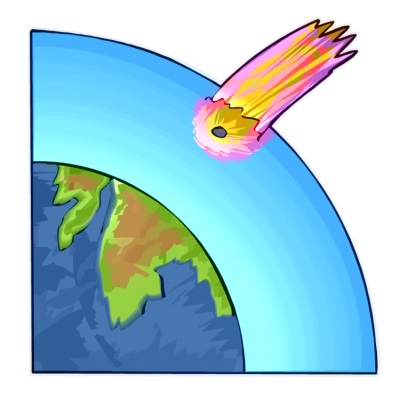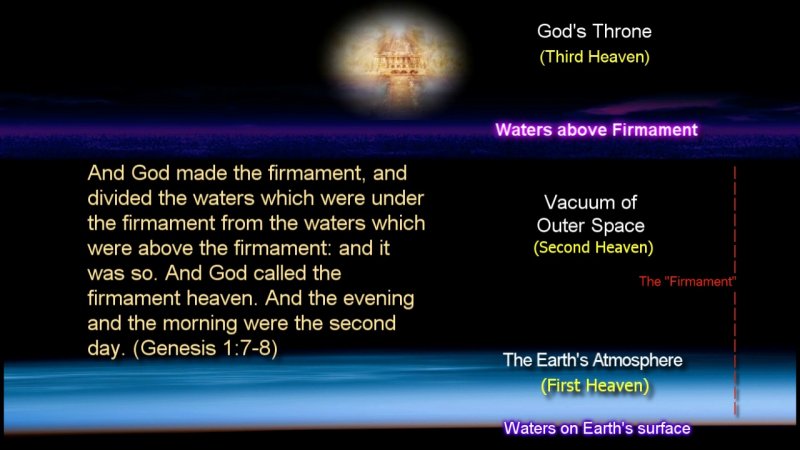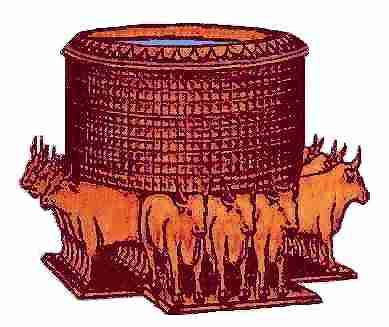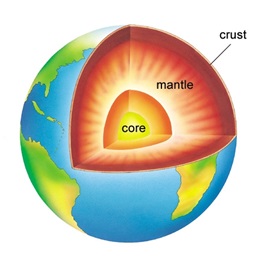The Firmament, Third Heaven, and Structure of Things Biblical

On the second day in the Genesis narrative the Lord calls for there to be a "firmament" in the "midst of the waters" to divide the waters:
"And God said, Let there be a firmament in the midst of the waters, and let it divide the waters from the waters. And God made the firmament, and divided the waters which were under the firmament from the waters which were above the firmament: and it was so. And God called the firmament Heaven. And the evening and the morning were the second day."
(Genesis 1:6-8 KJV)
The term "firmament" and its identity has been one of the greatest puzzles concerning the Creation account, mostly because of its Hebrew definition:
רָקִיעַ raqiya` raw-kee'-ah
from 7554; properly, an expanse, i.e. the
firmament or (apparently) visible arch of the sky:—firmament.
רָקַע raqa` raw-kah'
a primitive root; to pound the earth (as a sign
of passion); by analogy to expand (by hammering); by implication, to overlay
(with thin sheets of metal):—beat, make broad, spread abroad (forth, over,
out, into plates), stamp, stretch.
Most people interpret this to mean just the expanse of the sky (the atmosphere) or outer space, or both (which it is), but the full meaning goes well beyond that simplistic interpretation. The creation of the firmament is associated with the placement of a defined heavenly structure. Many modern scholars consign the term "firmament" as a relic of a pre-scientific culture and translate the Hebrew word raqia as a "dome" or "vault" in some modern Bibles, but it is rendered as "firmament" in the KJV for good reason. The problem that puzzles people is the implication in the Hebrew language of the firmament being a firm, fixed structure (FIRMament). That structure, and the KJV word choice, can be explained in the context of the Ruin-Reconstruction interpretation of Genesis.
The Creation Scientists of today's Fundamentalism (Young Earth Creationists) have interpreted the "waters above the firmament" as a theoretical "water canopy" which once surrounded the Earth, but no longer exists. They cite this as their source for the waters of Noah's flood. This is absolutely incorrect and a concept that does not exactly hold water (pun intended) when closely examined within the literal framework of the Bible's Genesis narrative. The reason is because of what is said in this passage:
"And God said, Let there be lights in the firmament of the heaven to divide the day from the night; and let them be for signs, and for seasons, and for days, and years: And let them be for lights in the firmament of the heaven to give light upon the earth: and it was so. And God made two great lights; the greater light to rule the day, and the lesser light to rule the night: he made the stars also."
(Genesis 1:14-16 KJV)
This verse says that the Sun, Moon, and Stars are "in" the firmament. Therefore, applying the rules of grammar and logic, those waters that are "above the firmament" must therefore be above the Sun, Moon and Stars. In other words, those particular waters are ABOVE the visible cosmos. For some this is a hard pill to swallow, but that is exactly what the Bible is saying.
"Praise him, ye heavens of heavens, and ye waters that [be] above the heavens."
(Psalms 148:4 KJV)
The Bible says that all wisdom and knowledge is found in the Lord Jesus Christ, the incarnate Word of God (See Colossians 2:3). The same holds true for the Holy Scriptures, the written Word of God. According to the Scriptures, there is a physical/spiritual structure to the universe. The Apostle Paul makes reference to the importance of this knowledge in the book of Ephesians where he wrote:
"That Christ may dwell in your hearts by faith; that ye, being rooted and grounded in love, May be able to comprehend with all saints what [is] the breadth, and length, and depth, and height; And to know the love of Christ, which passeth knowledge, that ye might be filled with all the fulness of God."
(Ephesians 3:17-19 KJV)
Pay close attention to the structure of the grammar. Paul is speaking about two different things in this passage. The first is the structure of things, "the breadth, and length, and depth, and height;" then there is the conjunction word "And" which is followed by the second thing, "to know the love of Christ, which passeth knowledge." In other words, Paul is saying there are two things the believer can and should know. 1) The dimensions and structure of all things physical things and how they are structured, 2) The love of Christ, a spiritual thing which is beyond full comprehension by man. A corollary to the truth of this passage is found in this Old Testament proverb:
"The heaven for height, and the earth for depth, and the heart of kings [is] unsearchable."
(Proverbs 25:3 KJV)
The firmament deals with the structure of the present heavens and Earth (Genesis 2:1), as opposed to the structure of the original heaven and Earth (Genesis 1:1). In the present heavens and Earth there exists a three (3) heavens structure. In the old world of the original creation, there was a different configuration. Let's look at Genesis 1:6 again and more closely:
"And God said, Let there be a firmament in the midst of the waters, and let it divide the waters from the waters. And God made the firmament, and divided the waters which [were] under the firmament from the waters which [were] above the firmament: and it was so."
(Gen 1:6-7 KJV)

On the second day of the regeneration, the Lord God "divided" the waters (plural) of the great "deep" into two (2) parts, with a "firmament" in the midst. According to Genesis 1:10, both the waters that were upon the face of the Earth and the waters which He placed above the firmament He called "Seas":
"And God called the dry [land] Earth; and the gathering together of the waters called he Seas: and God saw that [it was] good."
(Gen 1:10 KJV)
We know that the waters on the Earth are called "Seas" in the Bible, but there is also another "Sea" that is spoken of in the Scriptures and that one is above the firmament. (Special note: Notice that the word "Sea" is capitalized at Genesis 1:10 in the KJV Bible). But, exactly where is "ABOVE" the firmament? During the seven-days of the Genesis regeneration the Lord God defined Three (3) heavens. The first heaven is the Earth's atmosphere:
"And God said, Let the waters bring forth abundantly the moving creature that hath life, and fowl [that] may fly above the earth in the open firmament of heaven."
(Gen 1:20 KJV)
The second heaven is the vast expanse of the physical universe - outer space as we call it:
"And God said, Let there be lights in the firmament of the heaven to divide the day from the night; and let them be for signs, and for seasons, and for days, and years:"
(Gen 1:14 KJV)
These two heavens constitute a continuum called the "firmament," and this firmament is collectively called "Heaven":
"And God called the firmament Heaven. And the evening and the morning were the second day."
(Gen 1:8 KJV)
The Third Heaven is above this upper "Sea," and this higher sea is below the Throne of God:
"And before the throne there was a sea of glass like unto crystal: and in the midst of the throne, and round about the throne, were four beasts full of eyes before and behind."
(Revelation 4:6 KJV)
This particular "Sea" is above the firmament (the known physical universe). It represents a firm and impassable barrier between the world of man (below) and the world of God (above).
"Then said the Jews, Will he kill himself? because he
saith, Whither I go, ye cannot come. And he said unto them, Ye are from
beneath; I am from
above: ye are of this world; I am not of this world."
(John 8:22-23 KJV)
Here are some additional proof verses in the Bible which refer to this particular Sea:
"Praise him, ye heavens of heavens, and ye waters that [be] above the heavens."
(Psalms 148:4 KJV)
This is the "sea" that John saw in his visions:
"And before the throne [there was] a sea of glass like unto crystal: and in the midst of the throne, and round about the throne, [were] four beasts full of eyes before and behind."
(Rev 4:6 KJV)
As we said, this is a present "sea" of separation is a FIRM and impassable barrier between the world of man (below) and the world of God (above) and they only way through there is in the Lord Jesus Christ. That barrier structure can be seen in the design of the Tabernacle and the Temple. It is represented by the Veil.
The diagram below shows a comparison of these things to the structure and layout of Moses' Tabernacle, which is the same basic arrangement used in the layouts of the First and Second Jewish Temples in Jerusalem.
The "Sea" under discussion is a barrier between the second and third heavens, represented by the veil between the 'Holy Place' and 'Holiest of All.'
The 'Brazen Alter' represents the Earth where the sacrifice was to be made. In Christian theology, the Brazen alter represents the Cross of Christ where the 'Lamb of God' was sacrificed. You MUST be washed in the Blood of the Lamb of God.
The 'Laver' in Moses' Tabernacle, and the 'Molten Sea' in Solomon's Temple (see below), were places for the priests to wash themselves before entering the 'Holy Place'. In the Christian doctrine of salvation by God's Grace, this represents where you are Sanctified, washed by the water of the Word of God (Ephesians 5:26-27).

The Third Heaven
This now gives us a better understanding of what the Apostle Paul was talking about in the book of 2 Corinthians 12:2, where he speaks of a place called the "third heaven":
"I knew a man in Christ above fourteen years ago, (whether in the body, I cannot tell; or whether out of the body, I cannot tell: God knoweth;) such an one caught up to the third heaven."
(2 Cor. 12:2 KJV)
Although the "third heaven" is not directly mentioned in the Genesis narrative, the established structure of all things is defined in Genesis 1 and, when understood, allows us to comprehend exactly where and what Paul was talking about when he mentions the "third heaven" in his letter. It also gives the reader a better understanding of John's vision in Revelation 4. Again, when the Lord God divided the waters He created a boundary which presently exists between the two lower heavens (which constitute the firmament) and the third heaven (where the throne of God is). That boundary is that "Sea," and again that "sea" is above the two lower heavens of the firmament. It is also likened in places to crystal or smooth glass:
"And the likeness of the firmament upon the heads of the living creature was as the colour of the terrible crystal, stretched forth over their heads above."
(Ezekiel 1:22 KJV)
The reason it appears like a smooth, crystal surface is because it is frozen:
"The waters are hid as [with] a stone, and the face of the deep is frozen."
(Job 38:30 KJV)"And they saw the God of Israel: and there was under his feet as it were a paved work of a sapphire stone, and as it were the body of heaven in his clearness."
(Exodus 24:10 KJV)
It is also likened to glass:
"And I saw as it were a sea of glass mingled with fire: and them that had gotten the victory over the beast, and over his image, and over his mark, and over the number of his name, stand on the sea of glass, having the harps of God."
(Revelation 15:2 KJV)
With this understanding of what exactly the Firmament is and the structure of all things that God made during the seven days, many things that were previously obscure suddenly take on real meaning and enrich the reader's understanding.
In summary, here is the structure of the physical world as it now exists from the face of the Earth upwards:
- The lower sea of physical waters (our seas and oceans)
- The first heaven (the atmosphere)
- The second heaven (outer space)
- The sea above outer space and below the third heaven (a sea of separation)
- And above it all, there is the Third Heaven.
"That Christ may dwell in your hearts by faith; that ye, being rooted and grounded in love, May be able to comprehend with all saints what [is] the breadth, and length, and depth, and height; And to know the love of Christ, which passeth knowledge, that ye might be filled with all the fulness of God."
(Ephesians 3:17-19 KJV)
The structure of the heavens is a recurring theme throughout the Bible. It is reinforced (in typology) throughout the Bible. For example, it is likened to the floors of a building, which we call "stories" and, sure enough, the same word is even used in the KJV Bible. It is used to describe the design of the heavens:
"[It is] he that buildeth his stories in the heaven, and hath founded his troop in the earth; he that calleth for the waters of the sea, and poureth them out upon the face of the earth: The LORD [is] his name."
(Amos 9:6 KJV)
This pattern of three (3) "stories" is also found in some other important things in the Bible, an example being the description of the design of Noah's Ark:
"A window shalt thou make to the ark, and in a cubit shalt thou finish it above; and the door of the ark shalt thou set in the side thereof; [with] lower, second, and third [stories] shalt thou make it."
(Genesis 6:16 KJV)
It is also used to describe the construction of the Temple:
"The door posts, and the narrow windows, and the galleries round about on their three stories, over against the door, cieled with wood round about, and from the ground up to the windows, and the windows [were] covered;"
(Ezekiel 41:16 KJV)
In the construction of Moses' Tabernacle in the wilderness there were three (3) main parts: 1) The outer court, where the brazen altar of sacrifice was. 2) The Holy Place, where the candlestick, table of shewbread, and golden altar of incense were. 3) The Holy of Holies where the Ark of the Covenant was. Again, note that between parts two and three was a curtain for a partition, which matches the "sea" above the firmament (in type) in the structure of the Three Heavens. It is no coincidence that all these Biblical things have a similar three-tiered structure. There is much spiritual insight to be gained in further study of those things:
- Three Heavens
- Three levels inside Noah's Ark
- Three floors in a section of the Temple
- Three sections to Moses' Tabernacle
Concerning the design of the Temple, keep in mind that Moses' tent Tabernacle and Solomon's Temple both had three (3) main parts:
- The outer court
- The holy place (where the table, lamp and incense alter was, outside the veil)
- The Most Holy Place (where the Ark was, behind the veil)
As you can see, this theme of structure based on threes is consistent throughout the Bible. Even the basic structure of the Earth has three (3) main divisions: the core, the mantle, and the crust.

Does the Universe really have a structure? When you go into outer space is there really any such thing as up and down, is there a top and bottom? Does the cosmos have a definite shape? We cannot observe such in our three-dimensional view of the universe, but is that all that is really out there? Not according to the Bible! In the words of Lord Himself there is a world above the one we live in and can observe:
"And he said unto them, Ye are from beneath; I am from above: ye are of this world; I am not of this world."
(John 8:23 KJV)
Just because we cannot observe or understand something does not disprove its existence.
In the next section, we are going to discuss disconnect between the apparent age of the stars and the universe and the concept of a regenerated heavens and Earth at the time of the seven-days of Genesis.
Disclaimer: External Links
from this website are for instructional or promotional purposes and do not
constitute an endorsement
by the The Bible, Genesis & Geology Ministry.
All original text © 1997 -
2021
Gaines R.
Johnson, D.D., D.Th.
The Bible, Genesis & Geology Ministry
Materials from this site may
be freely copied to paper for personal use or church Bible studies.
They may not be reproduced
elsewhere on the Internet, for either personal or commercial use, without
the express written permission of this Ministry.
Are you saved? Are you Sure? Click the image below for the Gospel Truth about the Lord Jesus Christ in your native language!


